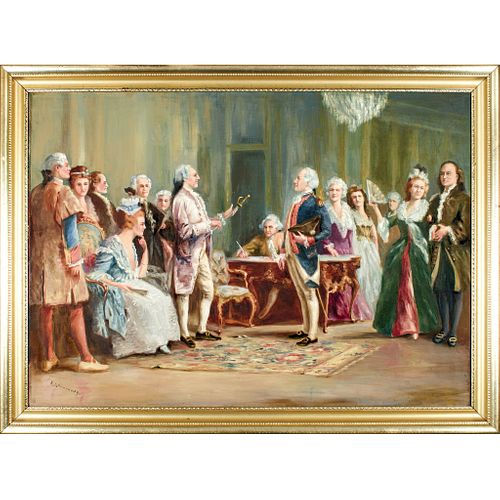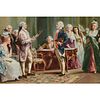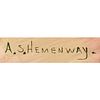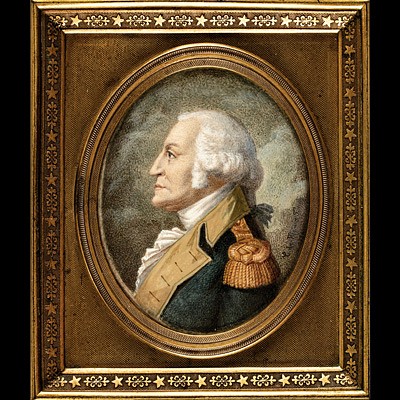George Washington Accepting a Sword from Lafayette Oil on Canvas Painting
Lot 109
Estimate:
$2,000 - $3,000
Absentee vs Live bid
Two ways to bid:
- Leave a max absentee bid and the platform will bid on your behalf up to your maximum bid during the live auction.
- Bid live during the auction and your bids will be submitted real-time to the auctioneer.
Bid Increments
| Price | Bid Increment |
|---|---|
| $0 | $10 |
| $200 | $20 |
| $300 | $25 |
| $500 | $50 |
| $1,000 | $100 |
| $2,000 | $200 |
| $3,000 | $250 |
| $5,000 | $500 |
| $10,000 | $1,000 |
| $20,000 | $2,000 |
| $30,000 | $2,500 |
| $50,000 | $5,000 |
| $100,000 | $10,000 |
| $200,000 | $20,000 |
| $300,000 | $25,000 |
| $500,000 | $50,000 |
About Auction
By Early American History Auctions
May 22, 2021
Set Reminder
2021-05-22 12:00:00
2021-05-22 12:00:00
America/New_York
Bidsquare
Bidsquare : Autographs-Colonial-Political-Americana
https://www.bidsquare.com/auctions/early-american-history-auctions/autographs-colonial-political-americana-6913
302 Lots of Rare, Historic Autographs, Americana, Civil War Era, George Washington, Abraham Lincoln, Slavery & Black History, Revolutionary War Era, Colonial America, Federal Period, War of 1812, Colonial Currency, Indian Peace Medals & more... Early American History Auctions auctions@earlyamerican.com
302 Lots of Rare, Historic Autographs, Americana, Civil War Era, George Washington, Abraham Lincoln, Slavery & Black History, Revolutionary War Era, Colonial America, Federal Period, War of 1812, Colonial Currency, Indian Peace Medals & more... Early American History Auctions auctions@earlyamerican.com
- Lot Description
American Revolution
Lafayette Gifts George Washington a Model-1767 French Officer's Epee, Alice Spaulding Hemenway's Artist's Vision
c. 1900, Oil on Canvas Painting, artist Signed, "Alice Spaulding Hemenway" (American, 19th Century), her vision of George Washington Accepting circa 1780, a Model 1767 French Officer's Epe (Sword), a Gift from the Marquis de Lafayette, Framed, Choice Extremely Fine.
The 1767 French Epe apparently depicted in this Painting was presented as a Gift to George Washington c. 1780 by Lafayette, and is currently located within the Museum at Mount Vernon. (Mount Vernon Ladies' Association; Gift of W. F. Havemeyer, 1892 Conservation courtesy of the Life Guard Society of Mount Vernon. Image: Stuart C. Mowbray). This large, highly colorful original Oil Painting on Canvas measures 29.75" x 42" (by sight), mounted in a decorative gold-gilt wooden frame to an overall size of 35.25" x 47.5." The artist's scene depicted in this Oil Painting has been described as, "George Washington receiving a Model 1767 French Officer's Epe (Sword) as a Gift from the Marquis de Lafayette." Lafayette, who helped the American Patriots defeat the British, extensively assisting General George Washington and the American Armies in his service throughout the Revolutionary War and was at Yorktown, VA. in 1781, at Cornwallis' surrender, effectively ending the American Revolutionary War. There are several "Historical" and factual issues inconsistent with this artist's visionary concept as shown, of the actual presentation "Gifting" event, but we leave that to her "artistic license" and appreciate it for its colorful eye-catching adaptation.
Apparently a depiction of Lafayette's presentation, it likely did not occur in a fancy parlor with Socialites with their ladies looking on. The gentleman at far right appears to be Benjamin Franklin, with likely Thomas Jefferson shown at left, along with other dignitaries. This Painting is not titled or dated, but it nicely signed. Perhaps the artist, Alice Spaulding Hemenway created this painting as her fanciful recreation of several events and attending people in this vivid painting. This cataloger gives our special thanks and acknowledgment: See: pp. 87-94 of the Washington Swords Book, by Erik Goldstein, Senior Curator of Mechanical Arts & Numismatics, The Colonial Williamsburg Foundation, for his kind assistance.
Stepping back and admiring the painting on its own merits, one is impressed with the size and colorful impression that would be a standout on display. Alice Spaulding Hemenway, born in Dedham, Massachusetts was a portrait painter, sculptor, teacher, and lecturer who was born in 1866 and who was active and lived in Florida and Massachusetts with most of her known artworks created c. 1900.
Per: GEORGE WASHINGTON'S MOUNT * VERNON:
https://emuseum.mountvernon.org/objects/294/model-1767-french-officers-epee;jsessionid=DCC67EBC0252064EB27A4A23A4F539AF
George Washington's Model 1767 French officer's epe was documented in his will:
"To each of my nephews, William Augustine Washington, George Lewis, George Steptoe Washington, Bushrod Washington, and Samuel Washington, I give one of the swords or cutteaux of which I may die possessed, and they are to choose in the order they are named. These swords are accompanied with an injunction not to unsheath them for the purpose of shedding blood except it be for self-defense, or in defense of their Country and its rights, and in the latter case to keep them unsheathed, and prefer falling with them in their hands to the relinquishment thereof." - George Washington, Last Will & Testament
This rather conventional sword was one of seven swords inventoried in George Washington's Study after his death, and the fourth chosen according to his will by Bushrod Washington, who also inherited the bulk of the Mount Vernon estate.
Although family tradition maintained it was George Washington's "mourning" sword because he purportedly wore it to funerals, recent scholarship has shown that it was more than likely a c. 1780 gift from the Marquis de Lafayette. Thus, it is certainly not the "Genteel Mourng. Sword, with Belt Swivels &ca." he received from London following the death of Martha Washington's daughter Patsy in June 1773.
Engraved inscriptions on blade are obscured and obliterated by corrosion. They were recorded by Benjamin Lossing in 1859 as follows (both in Latin): on one side, "RECTI FACE ICE" ("Do what is right") and on the other "NEMINE TIMEAS" ("Fear no man.").
Our Auction Contents:
Black History & Slavery: (Lots 1 - 63)
Abraham Lincoln Related: (Lots 64 - 74)
Historic Autographs: (Lots 75 - 235)
Colonial America: (Lots 236 - 261)
Revolutionary War: (Lots 262 - 304)
George Washington Related: (Lots 305 - 306)
Early American Guns & Weapons: (Lots 307 - 318) - Shipping Info
-
Early American provides in-house worldwide shipping. Please contact us directly if you have questions about your specific shipping requirements.
-
- Buyer's Premium



 EUR
EUR CAD
CAD AUD
AUD GBP
GBP MXN
MXN HKD
HKD CNY
CNY MYR
MYR SEK
SEK SGD
SGD CHF
CHF THB
THB













